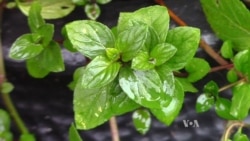While apples, corn, and cranberries top the list of fall produce in the US, this is also the time to harvest gum, candy, and toothpaste—or at least the oil that makes them minty fresh.
That oil comes from the plants grown by the country's 280 mint farmers, including Randy Matthys. Walking into one of his fields at Shady Lane Farms in Indiana is like unwrapping a giant piece of mint gum. The fresh scent permeates the air, clings to clothing, and sticks with you for hours.
Matthys is proud to grow what he calls the "peppermint and spearmint that help flavor the world." His great-grandfather started growing mint here in the 1930s. The farm has expanded since then, but the family still grows the same strain of Black Mitchum peppermint, brought over from Great Britain in the 1700s.
The crop is treated much like hay. After it's cut, it's left on the ground for about two days to dry. Then the farmer harvests it with a customized tractor that chops the plants and blows them into a large tank. There are five long pipes in the tank, and when the tractor arrives at the distillery, steam is forced into them. "So that steam bursts the oil glands in the leaves, carries the oil out in vapor form. Then the vapor goes through what we call the condensers," Matthys explained.
Mint isn’t traded on the commodity exchange like other crops. Instead, a broker contracts directly with growers to buy it. Last year, Matthys harvested 60,000 pounds of oil. Because mint is such a specialized crop, which needs expensive customized equipment, fewer and fewer farmers are planting it. But the ones who are currently supply 70 percent of the world’s mint needs, with the industry valued at more than $200-million a year.
China, India, and Japan are important markets for mint, not only for sweets but for home remedies. It's used to treat headaches, held ease cold symptoms, and - of course - it's great for tea.
Matthys notes that because of the crop's high demand and high cost, more and more manufacturers are developing synthetic mints.
"I want people to know to look on the label of that chewing gum or whatever mint product it is," he said. "Does it say natural flavor on it or does it say artificial?"
If that label is from Wrigley, Colgate, or Nestle, there’s a good chance you’re tasting some of Matthys’ mint!






